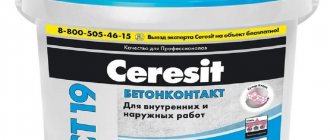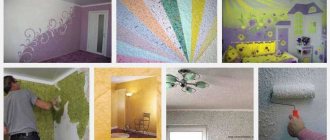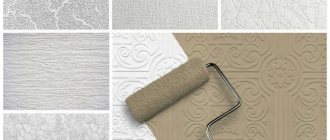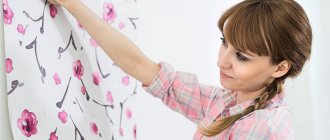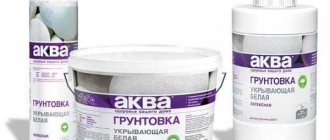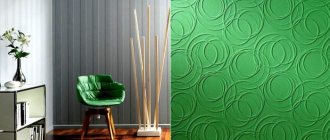Types of wallpaper for painting and their features
Wallpaper for painting, like a blank canvas of an artist, provides scope for the embodiment of the most daring creative ideas. After painting, they can become an accent of the interior or successfully emphasize it with color and texture. In order for everything to work out as planned, it is important to choose the right basis for the future masterpiece.
Paintable wallpapers have different base materials and textures.
Wallpaper intended for painting is wider than usual and much longer; two or three rolls are enough to cover an average room. Trade offers a choice for any demand. To avoid mistakes, you need to take into account the basic characteristics of the coating.
Material of manufacture
There are three types of wallpaper for painting:
- paper;
- non-woven;
- fiberglass.
Paper ones consist of two layers impregnated with a moisture-repellent composition. They are inexpensive, easy to glue, but short-lived and inferior in density to other types. They also have lower abrasion resistance.
Non-woven fabrics are resistant to stretching and tearing and do not wrinkle. The structure of the base is porous, allows air to pass through, due to which the walls “breathe”. A pattern is applied to the non-woven base using foam vinyl, which is why they are also called vinyl.
Their density is higher, and this allows you to hide minor defects and unevenness of the walls - there is no need to carefully prepare the base before gluing. Such wallpapers are more expensive than paper ones, but they will last much longer without losing their properties.
Fiberglass is made from a fiber similar to glass wool. The most dense, wear-resistant and durable type, but also the most expensive. They adhere well to the wall, creating the effect of a seamless fabric, hiding all defects in the base. Repels moisture and dust, fire and heat resistant.
The features of the base must be taken into account depending on the purpose of the room and the microclimate in it.
- Due to its low strength, paper wallpaper should not be used to cover walls in the nursery and hallway. But for the ceiling they are quite suitable.
- In rooms with high humidity, it is also better to prefer non-woven or fiberglass.
- The strength and wear resistance of the fiberglass base allows it to be used even for office and public spaces.
Another important characteristic is texture.
Texture
Most often, wallpaper is produced with a convex pattern on the front side, but smooth ones are also available. Considering that the coating will last at least 10 years, choose the appropriate texture:
- smooth;
- small drawing;
- large pattern;
- fabric imitation;
- geometric pattern;
- floral ornament;
- floral pattern.
Consider the area of the room, its purpose, interior and color of the future coating. So, a smooth base with a small pattern or imitation of stucco is suitable for the ceiling. A large pattern looks good in a spacious room, imitation fabric will create an atmosphere of warmth and comfort in the bedroom, a geometric pattern is appropriate in a study, hallway or office.
The walls can be left unpainted; this will not reduce the dignity of the coating. If the design involves color, choose the paint responsibly.
Is it possible to repaint if they are torn?
Answer: yes, but not always.
Most paintable wallpapers are multi-layered. In this case, with minor scratches, abrasions, or any other damage that does not affect the base layer adjacent to the wall, painting is permitted and should not cause difficulties. But if the wallpaper is old and torn because its integrity has been compromised, the tear may expose the wall, in which case care must be taken to repaint the surface.
Important
The solvent contained in the coloring composition can damage the wallpaper glue, then the fabric at the break point will bubble and may peel off. It’s better to cover the gap with a small amount of putty and then paint on top.
Paint selection
The following paints are used to paint wallpaper:
- water-based;
- water-dispersed;
- latex;
- acrylic.
Each type of wallpaper requires its own paint:
- It is preferable to paint paper ones with water-based emulsion;
- water-dispersion and water-emulsion are suitable for non-woven materials;
- glass wallpaper is covered with latex and acrylic.
This division is conditional. It happens that non-woven ones are coated with latex or acrylic paint, or fiberglass ones are painted with water-based paint. The choice also depends on the room.
- It is better to cover the walls in the bathroom and kitchen with latex or acrylic paint; it creates a waterproof film on the surface. This coating can be washed frequently without fear of damage.
- Latex paint should also be preferred for rooms exposed to the sun. It does not fade and retains its original color for a long time.
- Water-based paint is washed off with water; it is not recommended to wash this coating.
- Water-dispersed water is not afraid of water; surfaces coated with it can be washed.
Paints also differ in reflective ability:
- glossy;
- semi-matte;
- matte;
- satin.
Each type of wallpaper has its own paint
Glossy reflects light best, creating the effect of a mirror surface. With its help, you can compensate for the lack of lighting and visually enlarge a small space.
Roller
Painting walls with a roller is the most popular because it does not require the use of special equipment. Painting wallpaper using a roller is faster than using a brush.
It is best to bring the roller vertically and then diagonally to the sides. The painting procedure is carried out in exactly the same way as in the case of regular wall painting.
What you need for painting
Before you start painting, prepare the necessary tools and equipment.
- paint rollers;
- brushes;
- cuvette or paint tray;
- masking tape;
- stepladder;
- a rag to remove splashes.
Before you begin, prepare your tool
We should also talk about rollers - this is the main tool for painting work. They differ in size and material of manufacture:
- foam;
- velor (short pile);
- fur (with long and medium pile).
For simple painting you will need two rollers: a small one and a large one. Small ones are convenient for painting the outline, large ones do the main work.
To paint textured wallpaper to the full depth of the pattern, you will need a roller with a pile of 1.5-1.8 cm. A velor roller with short pile will help to roll only the pattern. For this purpose, you can also use foam rubber, but when painted it leaves bubbles on the surface.
The relief pattern is painted over with a long-nap roller
The brush is used for painting hard-to-reach areas where working with a roller is impossible. These are corners, crevices, areas behind pipes. It also paints the outline of the ceiling and floor.
You will need adhesive tape to protect ceiling skirting boards, sockets, pipes, window slopes, and so on. If the walls will be painted in two or more colors, use tape to mark the border.
Paint is poured into the cuvette or tray. The ribbed surface helps to completely saturate the roller and remove excess paint from it.
Before pouring paint into the cuvette, place a bag over it. You don't have to wash the bath after work.
Preparing the wall
Before you paint regular wallpaper, you need to tidy up the wall. The procedure is quite simple, and perhaps even simpler than preparing for gluing new wallpaper:
- First of all, remove all the furniture that can be removed from the room.
- Move the one that remains away from the walls and cover it with plastic wrap.
- Remove dust from the wallpaper using any suitable method, preferably with a vacuum cleaner, but you can also use a soft cloth.
- If possible, get rid of stains - they, of course, will go under the paint, but it is better if the surface is as uniform as possible.
- Cover the baseboard with masking tape - you can get by with wide tape, but this is not very convenient.
- If pieces of wallpaper have come off the walls somewhere, glue them on or remove them.
- If it is not glued very evenly, sand the area with fine sandpaper.
Important! You need to remove not only dust, but also cobwebs, if any.
Primer
After the walls are prepared, you need to apply primer. This is a fairly simple procedure, familiar to anyone who has ever done repairs. Compositions may vary.
For painting paper wallpaper, for example, a PVA-based primer is suitable. Water-based paint fits perfectly on it. The most important thing is to let the wall dry completely. In this case, starting work a little later than planned is much more useful than rushing. You need to wait at least a day.
Important! When applying primer, the room must be completely closed; the room cannot be ventilated until the composition has completely dried.
What you need to know before dyeing
- The wallpaper to be painted must dry completely after gluing. This usually takes 2-3 days.
- The first time the coating is painted at least twice. The second layer is applied only after the first has completely dried; the drying time is indicated on the paint packaging and is at least an hour.
- It is recommended to prime fiberglass before painting; this information is indicated in the annotation. Non-woven and paper ones do not require additional processing.
- After pasting non-woven wallpaper, remove all traces of glue, otherwise the paint will lie unevenly.
- Keep in mind that when painting in several layers, the final color will be more saturated. Therefore, it is recommended to make the first layer a little lighter than the next one.
- The paint should have the consistency of liquid sour cream. If necessary, dilute the paint with water or solvent and mix thoroughly until smooth.
- The optimal temperature for painting work is 17-22C.
Having prepared everything you need, get to work.
How to paint correctly: work order
- Clear the room of bulky furniture. If this is not possible, cover it with film.
- Cover with tape all elements that do not need to be painted.
- Cover the floor with protective material.
- Wear work clothes, a hat and gloves so you don't have to wash off the paint.
- To ensure that no lint remains on the surface from the new rollers, roll them over masking tape; the lint will remain on the adhesive surface.
- Pour enough paint into the cuvette so that it fills the recess, but does not cover the grooved surface.
- Start coloring from the top. Use a brush to paint a 5-7 cm wide outline around the perimeter of the ceiling. Use a stepladder.
- Roll the small roller in the ditch until it is completely saturated with paint. Remove excess on a corrugated surface.
- Paint the walls along the ceiling the width of the roller.
- Change the roller to a large one and saturate it with paint.
- Paint the walls from top to bottom using vertical movements. Try to apply the paint evenly and not saturate the base.
- Paint hard-to-reach areas and areas down to the floor with a small roller and brush.
- After the paint has dried, apply a second coat.
- Remove splashes with a rag.
- After use, rinse the rollers and brushes and dry them.
How to carry out the procedure correctly?
One of the advantages of paintable wallpaper is that it can be repainted from time to time. At least that's what most consumers think. But many who tried to do this were very disappointed with the result. In what cases is this idea good, and when is it better to just re-glue new ones?
Evaluate how well the coatings adhere to the wall. If they have already started to show noticeable bubbles and have sagged in some places, then an additional layer of wet paint will make the canvas heavier and make it completely peel off (how to remove bubbles on wallpaper and what to do if the coating peels off?).
If they hold up well, you can start painting. There are several rules.
- First, according to the relief: the finer it is, the greater the chances of painting it over.
- The second is the cleanliness of the paintings. The less dust on them, the better the paint will adhere. To clean the wall, you can use a vacuum cleaner or simply walk over it with a damp cloth. The surface must be completely dry.
- If the color is not too saturated or the previous color is still striking, you should wait until the painted canvases are completely dry, and only then try to paint them again, with a second layer.
Non-standard design of papered walls
Wallpaper for painting makes it possible to decorate the walls with several colors, apply gradient coloring, apply a pattern, highlight the texture and much more.
Selecting a texture
The painting technique allows you to highlight the pattern on the wallpaper and make it three-dimensional. You can do this in several ways:
Method 1
Suitable for non-woven wallpaper. As already mentioned, this type of base is also painted from the inside out. The paint will show through from the front side and create a background for the convex pattern. The design is left white or painted with a short-pile velor roller with a darker or lighter paint, but a different shade can be used.
Method 2
Instead of the wrong side, sometimes the wall under the wallpaper is painted a bright color. The base will mute the color, make it softer and highlight the textured pattern. As with the first method, the design is painted with a different shade or left white.
Method 3
Freshly painted wallpaper is lightly wiped with a damp cloth, removing the paint from the pattern. You need to act carefully and without pressure. After the wallpaper has dried, the pattern is painted in a different shade.
Painting in several colors
It is used to highlight one or more zones in a room, add bright accents, create a desired interior style, or simply for self-expression.
Colors are combined according to certain rules:
- A combination of related colors (lilac with gray, mint with blue and others).
- Gradient coloring, that is, combining different shades of the same color from intense to pale or vice versa.
- Emphasizing colors with a combination of contrasting shades (red and green).
To create a harmonious contrast, knowledge of color schemes will not hurt. If this is not your strong point, follow the rule: use only those combinations that occur in nature and do not combine more than two colors.
You can combine colors vertically, horizontally or diagonally - the choice depends on the goal. For zoning, a vertical combination is used; for the implementation of design ideas, a horizontal or diagonal combination is often used.
Zoning
This technique is used to highlight several functional areas in one room. For this purpose, a combination of saturated color with a softer shade is used - a gradient.
Painting the walls in different colors makes the room unique
Whether one of the walls will be a different color or all the walls will be different shades depends on your vision of the interior. This technique is used to highlight a recreation area or workplace in a common room. If there is a niche or ledge in the room, play with a different shade.
Horizontal or diagonal division
The classic version of the horizontal division of the wall: the lower third of one color, the upper two thirds of another. They can simply be separated by an even border, or decorated with moldings, borders, ornaments, mosaics, or whatever your imagination dictates.
But no one is forcing you to stick to this particular option. The border can run in the middle of the wall, above, below or almost under the ceiling. This is your home and you decide how it will look.
It is not necessary to make the border straight. Make it wavy, blurry, broken or radius, dividing the wall diagonally, combine horizontal and vertical lines and stripes.
Borders of different colors are covered with tape to keep the lines clean. 10 minutes after painting, the tape is removed.
Design options
Before painting a room, you should think about the overall color scheme and design. Depending on the idea and the overall tone of the interior, you can paint a wall in different ways.
- Single color paint. The most common, simple and fast option, suitable for discreet and austere interiors.
- Painting in several tones. Here you can already show your imagination. You can paint each wall a separate color; sometimes it is necessary to highlight a niche with color, create a frame under the head of a bed or a false fireplace, etc. Colors can be alternated on one wall, creating stripes, diamonds, or applying paint in several layers using stencils.
- Uneven paint application. This method is especially appreciated in grunge or loft style interiors. The paint is applied with sharp strokes, sometimes diluted with a solvent to create an uneven texture and smudges.
- Craquelure effect. Created with a special varnish. Applied on top of the main background, it causes the paint to crack openly. Adds a slight antique effect, emphasizing the sophistication of the room.
- Gradient. If you paint the wall with two different shades, and then, even before the paint dries, start mixing it carefully (at the junction of colors) with a dry roller, you can get a very smooth, beautiful transition.
Some useful tips
- After painting, the wallpaper can be covered with a layer of acrylic varnish. It will fix the paint layer, protect it from moisture and allow you to wash the wallpaper.
- Paper wallpapers are designed for 5 repaintings, non-woven and fiberglass wallpapers can withstand up to 10.
- Wallpaper overloaded with paint will lag behind the walls.
- The more layers of paint, the less noticeable the relief pattern.
- Latex and acrylic painting allows you to wash wallpaper without fear of damaging it. These paints create a waterproof film.
Paintable wallpaper provides ample opportunities for decorating interiors in different styles. By showing your imagination and putting your hands to work, you can give your living space individuality and originality. Imagine, create and bring your ideas to life.
- Author: Irina Vasilyeva
Hello! My name is Irina, I am 48 years old. Rate this article:
- 5
- 4
- 3
- 2
- 1
(23 votes, average: 4.1 out of 5)
Share with your friends!
Can they be painted?
Thick non-woven wallpaper is produced especially for painting. They tolerate staining well. For example, acrylic or simple water-based latex paint is suitable. This option is ideal for obtaining pastel colors. If you need bright colors, it is recommended to use acrylic.
Is it possible to paint non-woven wallpaper without painting it with a pattern? Yes. At the same time, you need to make sure that the paint content cannot “soak” the texture and harm the design. How to paint non-woven wallpaper without painting? Painting is carried out in a standard way.
Thick non-woven wallpaper is produced especially for painting.


